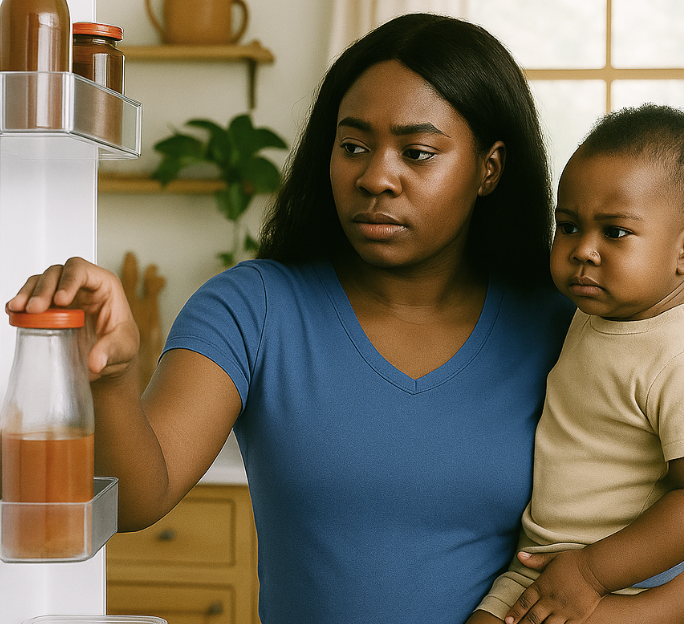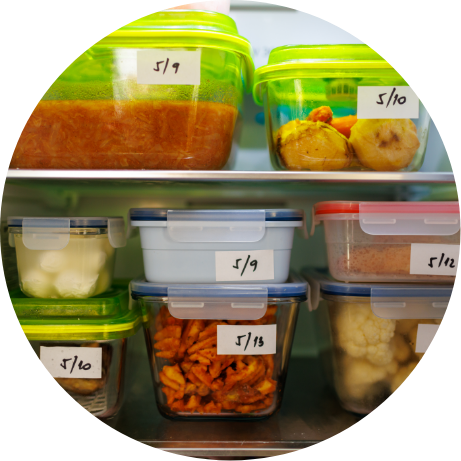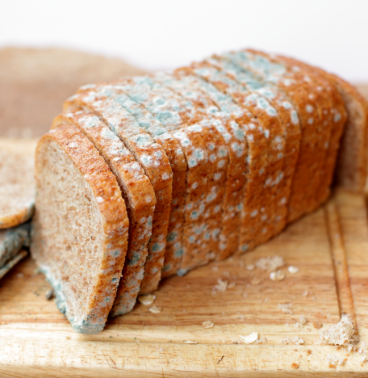
Kendra found some leftover chicken in her fridge.
She didn’t remember when she made it.
Should she keep it or throw it away?
She didn’t want to waste food—but she also didn’t want to make her family sick.



Kendra found some leftover chicken in her fridge.
She didn’t remember when she made it.
Should she keep it or throw it away?
She didn’t want to waste food—but she also didn’t want to make her family sick.
To stay safe, remember these four food safety rules:




Food can have harmful germs like bacteria, viruses, or parasites.
These germs can make you sick. Most food has some bacteria, but how you store, clean, cook, and handle food can stop it from becoming dangerous.
About 1 in 6 Americans gets sick from food every year.

If something smells bad, it probably is bad.
But food can look or smell fine and still be unsafe. It’s better to follow a schedule.
Here’s a chart to help:
| FOOD | FRIDGE | FREEZER |
|---|---|---|
| Ground beef, pork, lamb | 1–2 days | 3–4 months |
| Organ meats | 1–2 days | 3–4 months |
| Steaks, chops, roasts | 3–5 days | 4–12 months |
| Leftovers, casseroles | 3–4 days | 2–3 months |
| Ground poultry | 1–2 days | 3–4 months |
| Chicken pieces | 1–2 days | 9 months |
| Whole chicken | 1–2 days | 1 year |
| Cooked ham slices | 3–4 days | 1–2 months |
| Whole ham | 1 week | 1–2 months |
| Hard-cooked eggs | 1 week | Doesn’t freeze well |
| Eggs in shell | 3–5 weeks | Don’t freeze |
| Deli salads (chicken, egg, tuna, etc.) | 3–5 days | Doesn’t freeze well |
| Fresh fish or shellfish | 1–2 days | 3–12 months |
| Cooked seafood | 3–4 days | 3 months |
| Processed meats (see below) | See below | 1–2 months |
|---|---|---|
| Bacon | 7 days |
It’s best to limit how much processed meat you eat like hot dogs, bacon, or deli meats. Eating too much has been linked to cancer. |
| Deli meat (opened) | 3–5 days | |
| Deli meat or hot dogs (unopened) | 2 weeks | |
| Hot dogs (opened) | 1 week | |
| Jerky, pepperoni | 2–3 weeks | |
| Raw sausage | 1–2 days | |
| Fully cooked sausage | 1 week |

Some mold is safe (like in blue cheese), but some can make you sick.
Don’t sniff moldy food—you could breathe in harmful spores.

Food
What to Do
Hard cheese (cheddar, Parmesan)
Cut off at least 1 inch around the mold.
Don’t let the knife touch the mold.
Firm fruits/veggies (carrots, cabbage, peppers)
Cut off at least 1 inch around the mold.
Hard salami, dry-cured ham
Scrub off the mold and eat.

If you see mold on one slice, throw the whole loaf away. Mold spreads fast, even if you can’t see it.
U.S. Department of Agriculture, Food Safety and Inspection Service. (2024). Foodborne illness and disease.
https://www.fsis.usda.gov/food-safety/foodborne-illness-and-disease
FoodSafety.gov. (2023, October 19). Cold food storage chart.
https://www.foodsafety.gov/food-safety-charts/cold-food-storage-charts
World Health Organization. (2015, October 26). Cancer: Carcinogenicity of the consumption of red meat and processed meat.
https://www.who.int/news-room/questions-and-answers/item/cancer-carcinogenicity-of-the-consumption-of-red-meat-and-processed-meat
U.S. Department of Agriculture, Food Safety and Inspection Service. (2013, August 22). Molds on food: Are they dangerous?
https://www.fsis.usda.gov/food-safety/safe-food-handling-and-preparation/food-safety-basics/molds-food-are-they-dangerous
Lui, N. (2024, October 24). Is it safe to eat moldy bread? EatingWell.
https://www.eatingwell.com/article/8038039/is-it-safe-to-eat-moldy-bread/
HAND EXPRESSION
How it works
Use your hand to gently massage and compress your breast to remove milk.
What’s Involved
Average Cost
Free
Side-Lying Hold
This hold is useful when:
Cross-Cradle Hold
This hold is useful when:
Clutch or “Football” Hold
This hold is useful when:
Cradle Hold
This hold is useful when:
Laid-Back Hold
This hold is useful when: